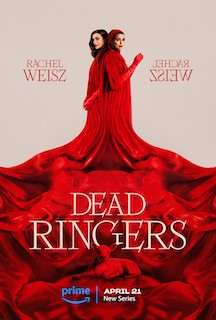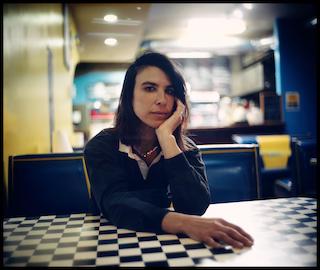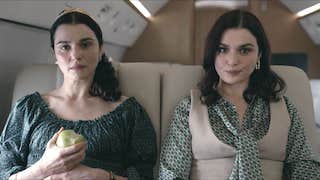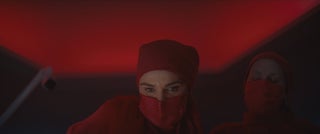 Director David Cronenberg’s 1988 horror film Dead Ringers, about twin OBGYNs whose penchant for tricking others threatens to shatter their own psyches, has received a sibling of its own with the six-episode Amazon miniseries of the same name. Starring Rachel Weisz as twins Beverly and Elliot Mantle, the show tracks a similar descent into madness, but one that’s carefully distinguished as a complement to its predecessor. All throughout the series, the color red plays a key role.
Director David Cronenberg’s 1988 horror film Dead Ringers, about twin OBGYNs whose penchant for tricking others threatens to shatter their own psyches, has received a sibling of its own with the six-episode Amazon miniseries of the same name. Starring Rachel Weisz as twins Beverly and Elliot Mantle, the show tracks a similar descent into madness, but one that’s carefully distinguished as a complement to its predecessor. All throughout the series, the color red plays a key role.
The miniseries’ dual cinematographers, Jody Lee Lipes, ASC and Laura Merians Gonçalves, worked together from pre-production, turning to Panavision New York for an equipment package built around Panavision G Series anamorphic lenses and Panavised Sony Venice cameras. Their prep time also found them working with Light Iron senior colorist Sam Daley, helped devise and refine shooting lookup tables for principal photography. Lipes photographed the first two episodes and Gonçalves shot the remaining four, with Light Iron providing dailies throughout and final color ahead of the show’s April premiere.
Here, Gonçalves discusses the miniseries’ visual opportunities, which were realized in close collaboration with Lipes and Daley from prep through post.
Digital Cinema Report: How would you describe the look of the series?
Laura Merians Gonçalves: Minimal, almost austere. The duality of the twins is part of the look — soft and beautiful but also graphic and brutal.
DCR: Were there any particular visual references that you looked at for inspiration?
 LMG: Every episode has a slightly different tone, so the references changed as the visual style expanded with the narrative. [Showrunner] Alice Birch and [lead director] Sean Durkin and I talked about Bergman's Persona, Altman’s Three Women and Zulawski’s Possession. The work of Thomas Eakins, who did some of the first paintings of surgeries, the photography of Gregory Crewdson, and Heji Shin’s birth portraits were also points of reference.
LMG: Every episode has a slightly different tone, so the references changed as the visual style expanded with the narrative. [Showrunner] Alice Birch and [lead director] Sean Durkin and I talked about Bergman's Persona, Altman’s Three Women and Zulawski’s Possession. The work of Thomas Eakins, who did some of the first paintings of surgeries, the photography of Gregory Crewdson, and Heji Shin’s birth portraits were also points of reference.
DCR: How did you and Jody decide to use G Series anamorphics for Dead Ringers?
LMG: Jody and I talked about different lenses but felt the G Series have certain characteristics, a specific softness, that we love. So, our primary lenses for the show were Gs, but each episode had additional specific needs. For example, one episode has some dream sequences and takes place in a mysterious house in Alabama, so the twins are outside of their familiar New York space.
For that episode, we added Primo Aristes for contrast, warmth and speed, and a 17.5-75mm Primo zoom that has this beautiful falloff. The twins’ relationship is starting to fracture during that episode, so the zoom was nice for those intense interactions. We also used a probe lens to be able to move around and capture the scale of the miniature model of the Mantle birthing center for the opening sequence of the show.
DCR: How did you end up partnering with Sam Daley at Light Iron for the final grade?
 LMG: Working with Sam has been great — he’s so talented. Sam and Jody have been collaborating for years, so that’s how we came to work at Light Iron. Jody used a gorgeous LUT that he and Sam had developed. When I started prepping, we knew the style of the show would shift to incorporate a lot more color, specifically reds. Sam and I were able to sit together, look at some tests, make modifications to the LUT, and get that red into a place we were both happy with. For Episode 6, which I lit mostly with candles, we did another modification, adding just a touch more color and warmth in the shadows.
LMG: Working with Sam has been great — he’s so talented. Sam and Jody have been collaborating for years, so that’s how we came to work at Light Iron. Jody used a gorgeous LUT that he and Sam had developed. When I started prepping, we knew the style of the show would shift to incorporate a lot more color, specifically reds. Sam and I were able to sit together, look at some tests, make modifications to the LUT, and get that red into a place we were both happy with. For Episode 6, which I lit mostly with candles, we did another modification, adding just a touch more color and warmth in the shadows.
DCR: What were some of the main areas of focus as you collaborated with Sam to finalize the look in the color grade?
LMG: Dialing-in the color red was a really big focus for us. It was sort of a nod to the original, that these characters are wearing red scrubs, and there are lots of different reds — from blood red to scarlet — that get introduced in the Mantle birthing center. We spent a lot of time looking at that.
For the HDR, Sam presented a pass that allowed us to maintain what we had established with our original SDR, which Jody and I were both really happy with. We were able to basically do side-by-side comparisons, delivering a beautiful HDR that embodied the very specific look and feel that we had worked so hard to achieve.
 DCR: How does this project differ from others in your career?
DCR: How does this project differ from others in your career?
LMG: I had never done an hour-long episodic miniseries, and it was technically complicated with the twinning. Thematically, it was gratifying to work on a show that has such strong, well-written and well-performed female characters. Also, watching somebody like Rachel Weisz work every day was really inspiring.
I didn't study film, but I knew I wanted to be a DP the first time I saw a cinematographer doing their thing. It seemed like a job that was only limited by your imagination. Watching Jody work and getting to know him was a highlight of this experience. Thought-provoking projects like Dead Ringers, where I get to push creative boundaries with brilliant people, really inspire me and keep me going.
Images courtesy of Amazon Studios.
